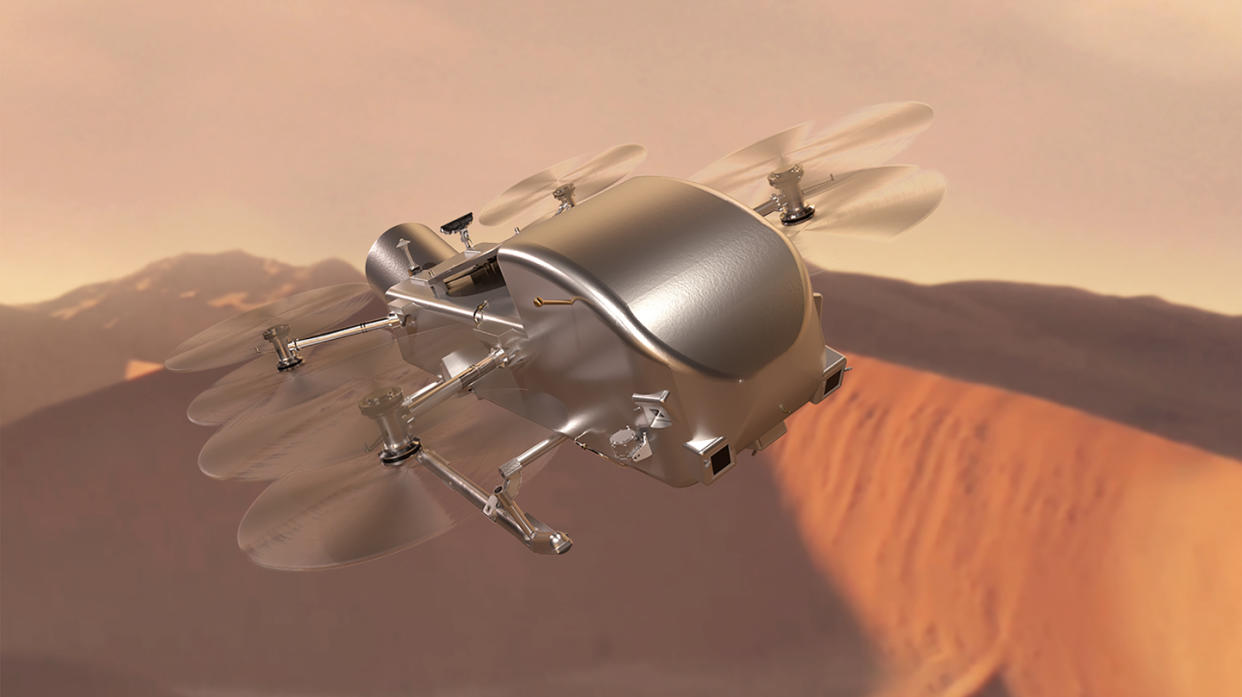NASA greenlights 2028 launch for epic Dragonfly mission to Saturn's huge moon Titan

NASA's delayed Dragonfly drone mission to Saturn's largest moon Titan is on track to launch in July 2028, the space agency confirmed late Tuesday (April 16).
The highly anticipated decision greenlights the mission team to proceed to final mission design and testing in preparation for the revised launch date.
The car-sized Dragonfly, which is being built by the Johns Hopkins Applied Physics Laboratory (APL) in Laurel, Maryland, will reach Titan in 2034. For the next 2.5 years, the nuclear-powered drone is expected to perform one hop every Titan day — 16 days to us Earthlings — hunting for prebiotic chemical processes at various pre-selected locations on the frigid moon, which is known to contain organic materials.
Related: Nuclear-powered Dragonfly mission to Saturn moon Titan delayed until 2028, NASA says
As the only satellite in our solar system known to be blanketed by a dense atmosphere and host liquid seas on its surface, Titan has long interested planetary scientists, who think the moon resembles the primordial, methane-rich Earth and could offer clues to the genesis of life. Rivers of hydrocarbons, combined with the presence of potentially life-supporting organic material, boost the case for Titan's habitability, which Dragonfly will help investigate.
While the Dragonfly mission passed a series of independent technical reviews early last year and was on track for its original launch date of 2027, NASA had postponed setting the final launch date due to uncertainty in how much money would be available for mission development this year and the next. The proposed 2025 budget request for NASA, released by the Biden Administration in early March, allocates $2.73 billion for robotic planetary exploration that includes the Dragonfly mission, whose total lifecycle costs will now be $3.35 billion, NASA said in a statement.
That final price tag is significantly higher than the initially proposed cost for Dragonfly, whose development was capped at $1 billion when it was first selected in 2019 as the fourth mission in NASA's New Frontiers program. The space agency said the mission's budget increased because of design iterations, supply-chain issues due to the COVID-19 pandemic and extra funds for a heavy-lift launch vehicle that would compensate for the delayed arrival at Titan by shortening the spacecraft's cruise phase.
RELATED STORIES:
— Strange winds blow on Saturn’s moon Titan. New clues could solve this decades-old mystery
— NASA's Titan Dragonfly will touch down on a field of dunes and shattered ice
Over a decade before Dragonfly actually flies on Titan, several of the drone’s components, including its control and navigation systems, have been tested on Earth. In July 2022, mission engineers flew a drone identical to Dragonfly over California’s Imperial Dunes, which resemble Titan’s organic-rich dunes, and in wind tunnels at NASA’s Langley Research Center in Virginia. NASA's official confirmation on Tuesday allows the mission to proceed to final design stages.
"Dragonfly is a spectacular science mission with broad community interest, and we are excited to take the next steps on this mission," Nicky Fox, associate administrator of NASA's Science Mission Directorate, said in the statement. "Exploring Titan will push the boundaries of what we can do with rotorcraft outside of Earth."


